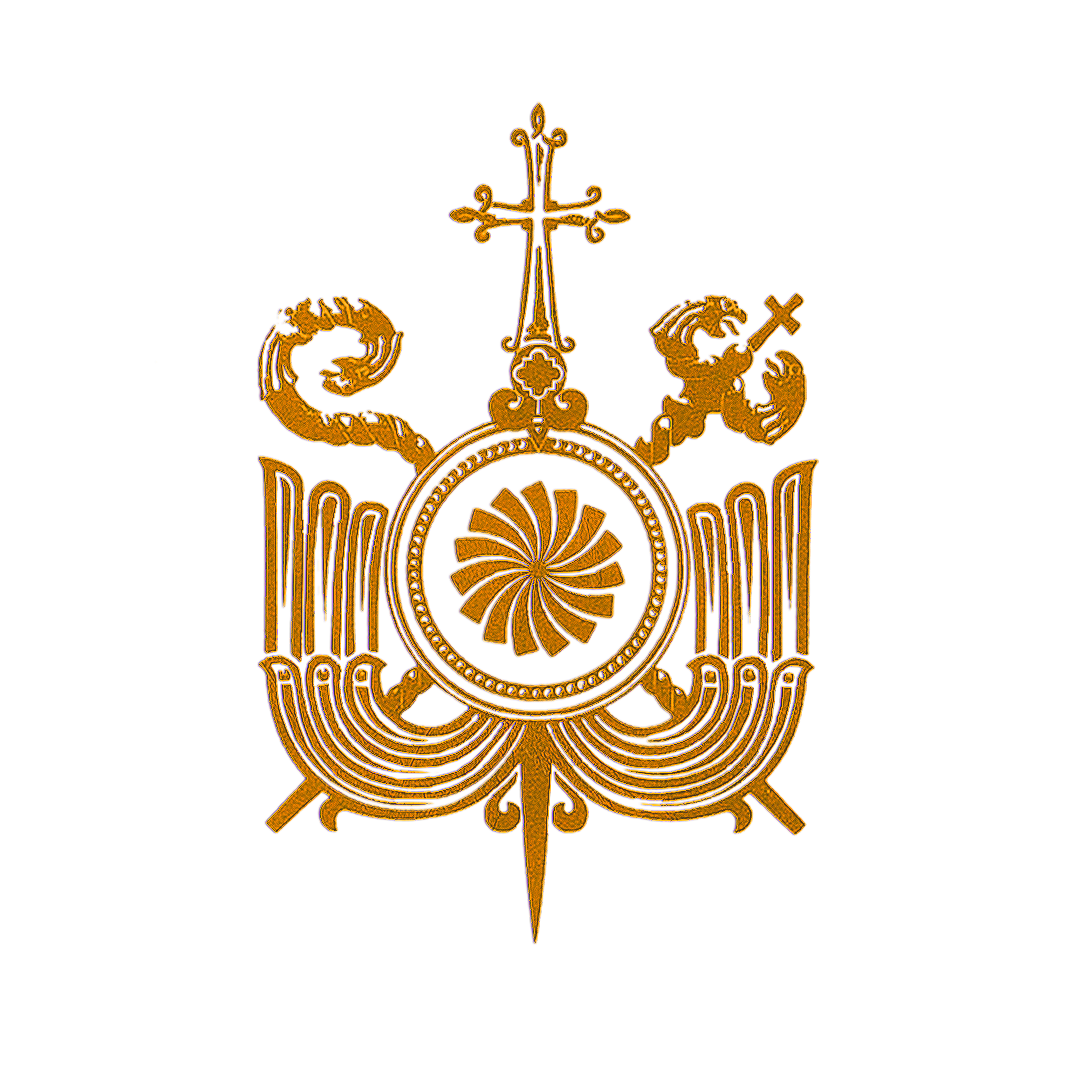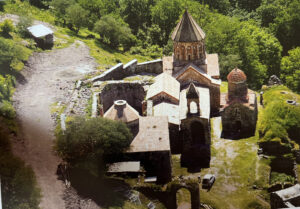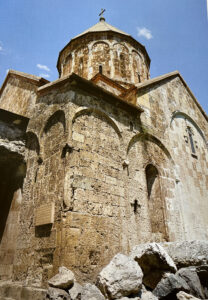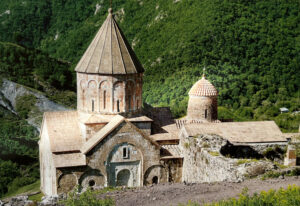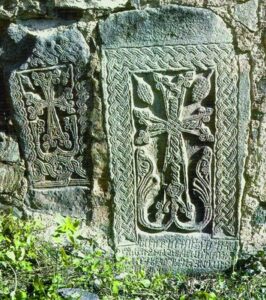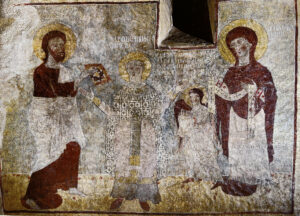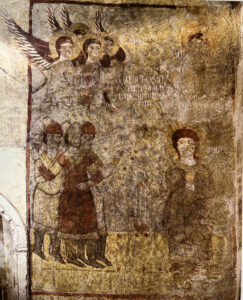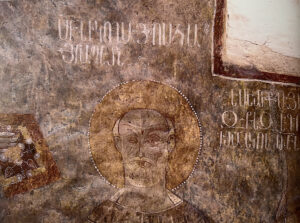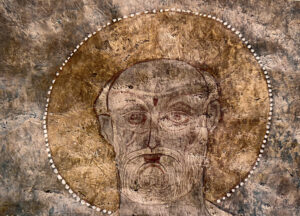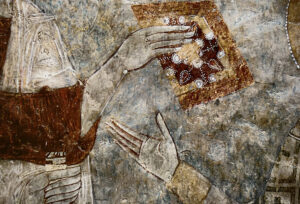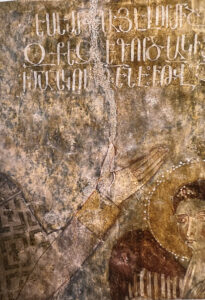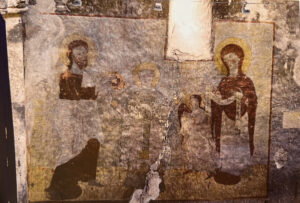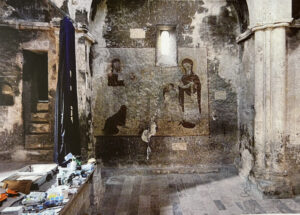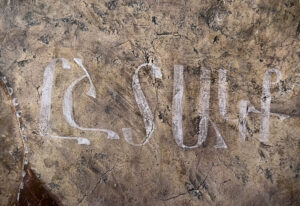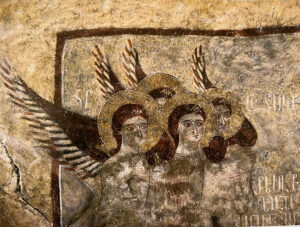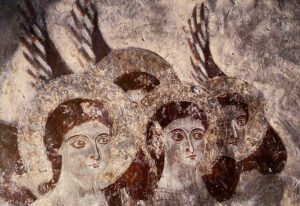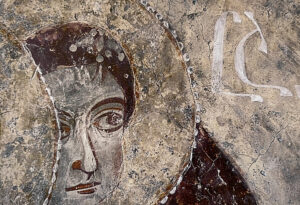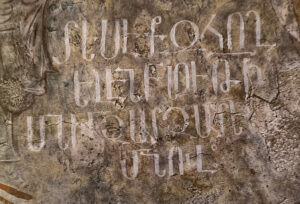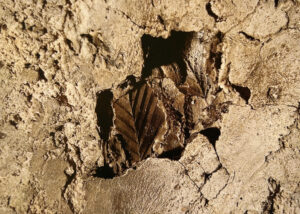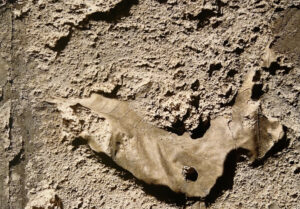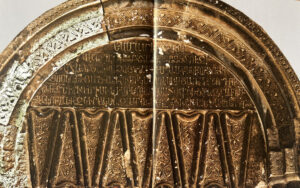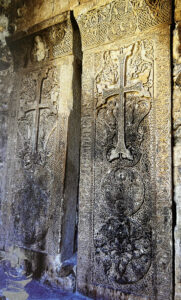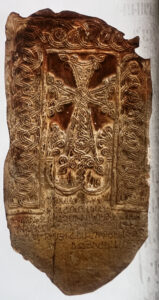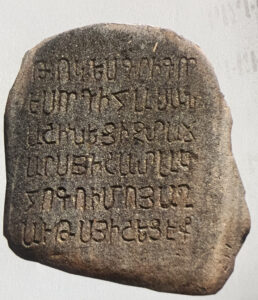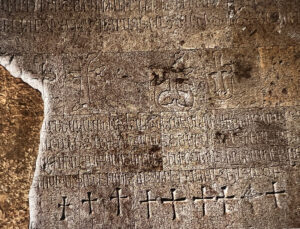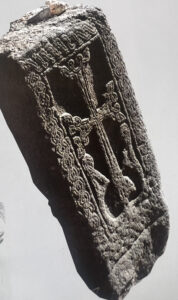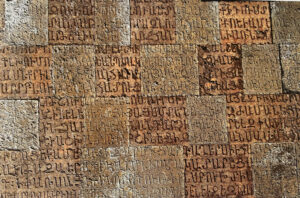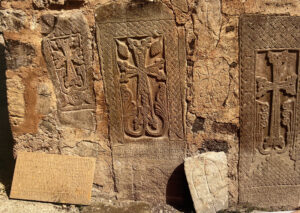The Orthodox encyclopedia, published with the blessing and under the editorship of the Patriarch Kirill of the Church of Moscow and All Rus', presents the history of Dadivank
Khutavank, Arakelots, Dadivank; monastery in the historical region of Artsakh of Great Armenia, in the gorge of the river Terter (Trtu).
According to story, one of the disciples of the Apostle Thaddeus, Dadi, or Dado, was martyred here (hence the name "Arakelots" - apostolic). The name "Khutavank" (literally - a monastery on a hill) goes back to the Armenian word "hut" (hill). According to chronicle sources, Dadivank was founded in the second half of the 1st century, and its name has been mentioned since the 9th century.
Dadivank was one of the oldest monasteries of the Armenian Apostolic Church, from the end of the 5th century subordinated to the Albanian Catholicos, in the Middle Ages it was the largest monastery of the Armenian Khachen Principality. Dadivank flourished in the 13th century. Dadivank was the episcopal residence, had vast estates, the monastery was served by a large village of Khut. Dadivank was repeatedly ruined and restored (for example: after the destruction by the Seljuks in 1145, it was restored in 1170).
In the XVIII century Dadivank was empty, due to the campaigns of the 90s of the 18th century Persian Agha Mohammad Khan Qajar, plague and famine depopulated the monastic villages, Kurds settled on the estates. In 1813, the territory of the Karabakh khanate and the monastery was ceded to Russia, after which Dadivank began to revive. Visited the monastery in the middle of the XIX century Archbishop Sarkis Jalalyants saw the ruins, which "served as a shelter for the robbers who raided Artsakh", the territory of the monastery was used as a pasture "for herds of sheep and cattle." Only by 1917, the manager L. Ter-Avetikyan managed to take away vast pastures from the Kurds and Turks, but with the establishment of Soviet power and after the transfer of the region to Azerbaijan, Dadivank ceased to exist. In the 60s of the 20th century a village was founded on the territory of Dadivank. Since 1993, the territory of the region has been controlled by Nagorno-Karabakh, since 1998, restoration work has been carried out in the monastery.
Cathedral Temple of Katoghike, 1214
On the territory of Dadivank, about 30 buildings have been preserved (4 churches, 2 gavits, a gallery, a bell tower and memorial and civil buildings).
The one-nave church of St. Dadi (walls that have partially sunk into the ground have been preserved) was built presumably in the 9th or 13th century. The second dating is confirmed by a 19-line inscription of the abbot of the monastery, father Atanas (in the central part of the southern facade, under the window, between the pilasters). The altar contains an early medieval stele over the tomb of St. Dadi.
A 4-column zhamatun (gavit, 1224) adjoins the church from the west, in the interior of which khachkars are installed or embedded in the floor along the entire eastern wall. A second vaulted gavit and a hall church with a rectangular altar join St. Dadi's church from the south.
Khachkars in the western wall of the small church (not earlier than 1211)
A gallery on columns, located along these two buildings, connects them with the cathedral temple of Katoghike, or Arzu-Khatun (1214), founded by Arzu-Khatun, the wife of Grand Duke Vakhtang. This is reported by the construction inscription in 19 lines. This is a cruciform inside and a rectangular outside domed church (12.3 × 10.6 m, height 18.5 m) with 2-storey chapels in the corners.
On the southern facade, on the sides of the window, there is a traditional ktitor relief composition depicting princes Hasan and Grigoris with a model of the temple. On the eastern facade, above the window and directly under the central arch, there are busts of St. Dadi and Prince Vakhtang with halos, also with a model of the church. The surface of both facades is filled with building and dedicatory inscriptions. On the north side of the main portal of the church there was an ornamented stone with the inscription: “Remember the sculptor Poghos”, which disappeared in the 80s of the XX century.
Fresco painting, created during the restoration of the temple in 1312, has been partially preserved. On the southern wall there is a scene of the presentation of a miter by Christ and a omophorion by the Mother of God to St. Nicholas the Wonderworker. On the right side of the northern wall is the scene of the stoning of St. Stephen.
The separately standing small southern church (not earlier than 1211) has the structure of a domed church, traditional for Armenia. Khachkars are built into the picturesque masonry, the drum is figuratively lined with brick and stone, the roofs and the tent are tiled.
Somewhat to the south of the small church there is an almost square building (1211), called in the construction inscription "tachar" (lit. - temple). 4 round columns support a vault system with an upper light hole. A refectory and a kitchen (XIII century) are attached to this building.
In the southern part of the monastery, there are several service and civil buildings. From the east, the temple is adjoined by a two-storey building consisting of 3 rooms (dated by Ter-Athanas inscriptions between 1263 and 1291), which is considered a library and a scriptorium.
The building of the bell tower (khachkars installed in the interior are dated 1283) is crowned with a rotunda with a pointed tent. The interior of the lower tier is decorated with paired khachkars.
In the south-east of the complex, several buildings adjoining each other for various purposes have been preserved: the prince's chambers, a chapel, a hotel, an oil mill, a cellar (all from the 12th-13th centuries).
Conservative restoration of frescoes from 1297 in the Katoghike church built in 1214
Monastery of Dadi is one of the best and most famous medieval Armenian architectural complexes: it is especially valuable for the variety of church and secular buildings, the originality of structures and equipment. It was rethought and supplemented after the restoration of the frescoes of the Katoghike church, after which one could admire the rich artistic imagery of the frescoes. These works on the restoration of frescoes gave a new direction to the revival of the monastery.
We consider it important to note that, fortunately, Armenian specialists managed to study and interpret the Artsakh school of Armenian architecture in the anti-Armenian environment of Soviet Azerbaijan, where many monuments of Armenian culture were destroyed. Only after the liberation of Artsakh, starting in 1993, it became possible to fully explore this historical region and carry out archaeological, survey and restoration work.
Dadi Monastery is one of the most important complexes of the Artsakh School of Armenian Architecture, unique in its location, landscape, spatial composition, perspective solutions, exclusive interpretation of individual buildings and beautiful paintings.
Researchers have already noticed that the greatest architectural merits of the Nshan church of Haghpat were applied in the Katoghike Church. The church of St. John the Baptist in Gandzasar also belongs to the same architectural composition, with significant proportional differences.
Frescoes of the Church of St. Mary of Katoghike
About the frescoes of the Church of the Holy Mother of God in Dadivank are written in a number of sources, which were studied by the restorers of the frescoes, the architect Ara Zaryan and Christine Lamure, a restorer from Italy. We read the first reliable description of the fresco scenes in the work of the outstanding Russian art historian Lidia Durnova: “The second painting is located in Dadi, in the temple built by Princess Arzu-Khatun in 1214 in memory of her husband and two sons, which is mentioned by us in connection with the decorative carving of outdoor decoration . The painting probably dates back to the restoration of the temple in 1312. It contains on the southern wall a large-scale scene of the return of the miter by Christ and the omophorion by the Holy Mother of God to Nicholas the Wonderworker, and on the northern wall - scenes of the stoning of Archdeacon Stephen (located on the right half of the wall). Patrick Tonapetian and Jean-Michel Nicole Thierry also made authentic interpretations of the scenes: ''From the inside, the walls were covered with frescoes. Only two subjects remain identifiable: the enthronement of St. Nicholas on the south wall and the martyrdom of St. Stephen on the north wall. These paintings, undeniably Armenian and no doubt modern buildings, are original adaptations of Greek or Georgian models in a refined linear style.”
Kirakos Gandzaketsi testifies that the author of the valuable painting on the southern wall is Arzu Khatun. That is, Arzu-Khatun was a worker of arts, she mastered the art of creating color shades of paints and ornaments, as well as weaving patterns of clothes. It is known from the bibliography that Arzu Khatun and his daughters sewed curtains for the churches of Nor Getik, Haghpat, Makaravank, and the Dadi monastery. This is the first mention of carpet tapestry in Armenian reality.
Having studied and restored the frescoes of the Church of the Holy Mother of God Katoghike of the Dadi Monastery, we can confidently state that they are a unique expression of the individual approach of Armenian art, enriching the continuous creative process of Armenian art of the mature Middle Ages in the Armenian province of Artsakh.
A reliable description of the fresco scenes became possible only after their cleaning and restoration, about which Karen Matevosyan noted: “The wall paintings of Dadivank, which are best preserved in Artsakh, are remarkable in terms of themes. One of the images, on the southern wall, represents a behavioral episode of the assumption of patriarchal authority by one of the greatest Christian saints, Patriarch of Myra of Asia Minor Nicholas the Wonderworker, and the other, on the northern wall, the martyrdom of St. Stephen.
The internal walls of the Katoghike Church of Dadi were completely plastered also because they used very porous, light limestone, which absorbs moisture like a sponge, and the plaster performed a heat-insulating role. As we can see, the frescoes in the church are located only on the northern and southern walls, and on top of the plaster used to paint them, the entire surface of the wall was re-plastered. Two frescoes are enclosed in red circles; they were located close to the eastern corners of the northern and southern walls in such a way that those entering the church, looking to the right and left of the main altar, immediately saw them. Around the niches of the main altar, the patterned parts of the frescoes have also been preserved.
The total area of the inner walls of the Church of St. Katoghike is 650 square meters.:
SOUTHERN WALL: " DEDICATION OF THE PATRIARCHAL POWER OF ST. NICHOLAS THE WONDERWORKER"
In the fresco on the southern wall, there is a behavioral episode of receiving the patriarchal power of St. Nicholas the Wonderworker (14 sq.m.), where to the left of the central image Christ hands him the Gospel, to the right the Holy Mother of God hands him a white orarion decorated with crosses, and the frail Archangel Michael stretches out his hands to the Wonderworker. This episode was confirmed during the cleaning of the fresco, when in the central part, on top of the halo of St. Nicholas the Wonderworker, a two-line inscription in Armenian was appeared: ՍԲ. ՆԻԿՈՂԱՅՈՍ ՀԱՅՐԱՊԵՏՆ (St. Nicholas the Wonderworker).
The fresco on the south wall depicts four standing figures in wonderful harmony against a blue sky with their feet on the brown earth. Blue sky and brown earth are separated by a white horizontal line. The majestic Jesus Christ and the Holy Mother of God tenderly rested their feet on red pillows (carpets). The fresco is completely enclosed in a 4 cm thick frame with a red border, inside which runs a thin white line parallel to it. Next to each of the four images, inscriptions of their names in Armenian are inserted beautifully and with high artistic taste. A three-line Armenian fresco inscription is inserted in the lower part of the window of the southern wall. It was extremely important to read the date of the last part of the inscription: ՉԽԶ, which corresponds to 1297 (Չ=700; Խ=40; Զ=6, which means 746+551=1297), that is, the frescoes were made 83 years after the founding of the church. Naturally, Princess Arzu-Khatun could not have had anything to do with the creation of the murals, because she could not have been alive in 1297.
To the left of the pictography, the fresco depicts Jesus Christ, leaning ¾ to the central figure, St. Nicholas, the left leg is directed forward with the desire to step, so it comes out a little from under the support of the red pillow and is slightly bent at the knee. The right hand of Christ, in the palm of which is the Gospel, decorated with nuances and magnificent composition, is directed to St. Nicholas. The left hand is at the waist and holds a scroll. The iconography of the 8th-century scroll is preserved in the church of Santa Maria Antiqua in Rome, on the frescoes of the Holy Doctors, which depict the same painting as in the composition of Dadivank.
All these selected scenes suggest that especially the church of the Holy Mother of God of the monastery of St. Dadi also retained the role of a healing shrine.
The long-sleeved red-brown mantle of Christ is girded at the waist with a white apron of fine and wonderful folds, which also falls gently on his left shoulder. The long hair and thick beard of Christ are reddish-brown in color with subtle painterly hues, done with great skill. The dexterous hand of the muralist is also visible in the area of the eyes and mouth of the figure, where the lines are confident and bold. In the center of the forehead are three tufts of hair, probably a symbol of the Trinity. Near the head, on the right side, an Armenian fresco inscription testifies: ՔՍ (meaning Christ)
An angel with red wings, bent by ¾, is also moving toward the figure of St. Nicholas, his right leg is one step forward toward the central figure. Hands covered with a scarf are directed towards St. Nicholas. The body of the angel is covered with a thin white himation, over which an apron is thrown over. “According to the iconography, this is a serving angel. Serving angels are usually depicted in scenes with Jesus Christ. Long hair is neatly styled and tied behind the neck, and an elegant pin flaunts on the forehead. The color of the hair and wings is reddish brown. A three-line Armenian inscription is inserted under the window:
ԵՍ ԵՄ Մ(Ի)ՔԱՅԵԼ ՈՐ ՄԻՇՏ ՊԱՀԵՄ
ԶՔԵԶ ԵԻ ԳՈՐԾԱԿԻՑ ԵՄ ՔԵԶ
Ի ՄԱՆԿՈՒԹԵՆԷ : Ի : ԹՎ ՉԽԶ
The fresco depicting the offering of patriarchal authority to St. Nicholas the Wonderworker was covered with a thick layer of compacted dust and dirt, which did not allow a clear view and interpretation of artistic and pictorial features. Due to the absolute indifference in Azerbaijan during the Soviet years, due to the continuous seepage of rainwater from the damaged gable roofs in the eastern corners of the southern and northern fresco walls of the temple, the stucco section degraded so much that it erased a significant amount of colored decor and stucco on the images of Christ as on northern and southern frescoes. On top of all this, in order to make the fresco visible, in 1993 soldiers tried to wipe the frescoes with oiled rags to get a better view of them without realizing the damage they had caused. In the 60s of the 20th century, the inner walls of the entire church were covered with black soot due to numerous fires lit by a large Kurdish family living inside the church. This was also a positive factor in the sense that the frescoes remained hidden under the soot and thus the criminals did not pay attention to them.
Four images: St. Nicholas the Wonderworker, Jesus Christ, the Holy Mother of God, Archangel Michael, next to each of them, with high artistic taste, their names are written in Armenian letters. Directly under the window on the southern inner wall, during the cleaning process, a three-line white handwritten Armenian inscription with a clearly readable date ՉԽԶ was found. This inscription has also been cleaned and restored.
The width of the mural depicting the offering of the patriarchal authority of St. Nicholas the Wonderworker is 5 m, the height is 3 m, i.e. 15 square meters.
NORTH WALL: "MARTYRDOM OF THE HOLY ARCHDEACON STEPHEN"
Pressed against the cornice of the eastern side of the northern wall, a fresco depicting the scene of the stoning of St. Stephen the Archdeacon has survived, consisting of four groups placed in two series of images. It is located in front of a large fresco on the southern wall, but almost half its size (6 square meters). It is not clear whether this fresco was painted in 1297 before or after the north doorway of the church was walled up, but nevertheless the frame of the fresco is placed on the wall in such a way that it could be inserted even if the door was in use. In place of the door in the wall, an arched niche for the font was left. As in the case of the mural on the south side, here the background of the mural is blue, and the lower part of the right and left sides is earthy brown. The border between blue sky and brown soil is white. In the upper image of the composition, above the image of St. Stephen, there is a poorly preserved image of Christ, and in front of it, above a group of torturers, a group of four angels. Holy figures and angels have halos, the borders of which are outlined by white spots.
For the color solution, the same shades of the southern wall were used. The central image of St. Stephen is frontal, and the red outline of the dress (sinopia) clearly outlines all the details of the outerwear. In his right hand he holds a censer, in his left - an incensory with a round lid. Hair reddish-brown, sideburns reaching to the shoulders. The footrests are also the same color. The face is whitish, behind the head is a gilded nimbus surrounded by white spots; on the right side, a two-line fragment of the name of the saint in Armenian has been preserved. In front of Archdeacon Stephen stands a group of six tormentors: three in front, three behind the first. They are dressed in red and yellow long secular clothes, they have hats of opposite colors on their heads, long red hair sticks out from under them, and black and yellow high boots are on their feet. One of those standing in front has a beard, the other has a mustache. Artfully drawn in black, the expression on the features is cold and indifferent. In the hands there are small red spherical stones, which are thrown towards St. Stephen. It is interesting that all the stones thrown in the direction of the saint miraculously stopped at the censer and did not fall into it, falling to the ground. It is interesting to note that the same red stones are painted on the earthen part of the mural on the northern wall. This proves that the frescoes on both walls were made at the same time and by the same group of artists. On the left side of the face of Christ, which is above the holy martyr, the letters ՅՍ (meaning Jesus) have been preserved, while the letters ՔՍ on the right side have disappeared. Perhaps the most striking pictorial symbol of the northern fresco is a group of four angels, which, together with the image of Christ, based on their location and size on the fresco, were originally conceived in the form of a bust. Two of the four angels are in the first row, the other two are hidden behind them. All eyes are on Christ. Wings and long hair tied at the back are reddish-brown in color, and on the forehead are beautiful pins made of several gems. There are two tufts of hair in the middle of the forehead. Behind their heads, all have gilded haloes with traces of silver plates preserved in places. They wear white, elegant and transparent robes. The expressions on the faces of the angels are heavenly, pure, and despite the tragedy of the fresco, bright and kind. To the left of the group of angels is written ՀՐ, to the right is written ԸՇՏԱԿՔ (ՀՐԸՇՏԱԿՔ), which means angels. Between the latter and the images of Christ, the words of Christ in Armenian are inserted in four lines:
ՏԵՍԷՔ ԶՀՈՂ
ԵՂԷՆ ԲՆՈՒԹԻ (ՒՆ) ՎՐԱ
ՍՆ ԻՄ ՉԱՐՉԱՐԵ
ՄՆՈՎ
“This phrase refers to the Martyrdom of St. Stephen and is taken from a poem dedicated to him, the author of which was St. Nerses Shnorhali.
The fresco depicting the scene of the stoning of St. Archdeacon Stephen, surrounded by the same thick red frame, is smaller: 2 meters long and 3 meters high - 6 square meters. Before the intervention, it was also almost invisible due to a thick layer of dirt and soot. Only after cleaning it became clear that the author of this painting is the same as the scenes of St. Nicholas because the same pictorial style and skill are observed. Moreover, the shape and color of the red stones are exactly the same as those painted on the opposite fresco below the white line on the ground separating heaven from earth.
All interventions for cleaning, fixing, and restoration were carried out in the same way as the fresco in front. In this case, too, there were many interesting studies that brought out the beauty and charm of the frescoes and confirmed that they were the work of the same artist or group of artists. The work began with a group of angels in the upper right corner. Their faces are noticeably idealized to such an extent that they seem supernatural, sexless, their hair is tied with the same cinnabar-colored ribbon as the archangel Michael on the fresco opposite, in the middle of which is a headdress with precious stones. Another interesting feature is the pair of tufts of hair painted on the foreheads of all the angels, reminiscent of the three tufts of hair of Jesus Christ on the fresco opposite. While working on the deck, we recorded another important fact: the presence of many small pieces of silver leaf preserved in the halos of angels indicates that their surface was completely silvery. Very well preserved drawings of the faces of angels, made by a confident hand, which, together with other lines in a sequence of shades of red and white, create shadows and give volumetric resolution to a group of angels. Their wings are similar to those of the archangel in the painting opposite, and here the edges of the wing feathers are painted with precious cinnabar paint. They also restored the white gentle scales of the angel's himation. The group of stoning warriors, standing below the angels, has a completely different solution because they are very lively and masculine, the looks directed at St. Stephen are fixed and menacing. The clothes are simple, secular, in the direction of the holy martyr they throw round red stones collected from the ground. In an effort to revive the icon, his right eye was restored in the same way as the left, in compliance with the rules and principles of intervention. Also important are the handwritten Armenian writings preserved on the wall, which were also cleaned.
While cleaning the stones of the dome on deck, experts noticed leaf and stem fossils embedded in the stones, which take thousands of years to form. Cleaning revealed a red and white patterned addition around the key, which has also been restored. It can still be seen today if you look carefully from the floor of the church.
During the cleaning process, under the soot and dirt, a four-letter Armenian cipher was found on the wall rising from the stage to the northern vault.
Khachkars and murals in the territory of Dadivank
The memorial stone of St. Dadi in Dadivank
Bibliography
- “Conservative restoration of the frescoes of 1297 of the Katoghike church built-in 1214” (2021), Yerevan, 483 pp.
- "Spiritual Treasures of Artsakh" (2015), Yerevan, 336 pp.
- Orthodox encyclopedia: www.pravenc.ru
